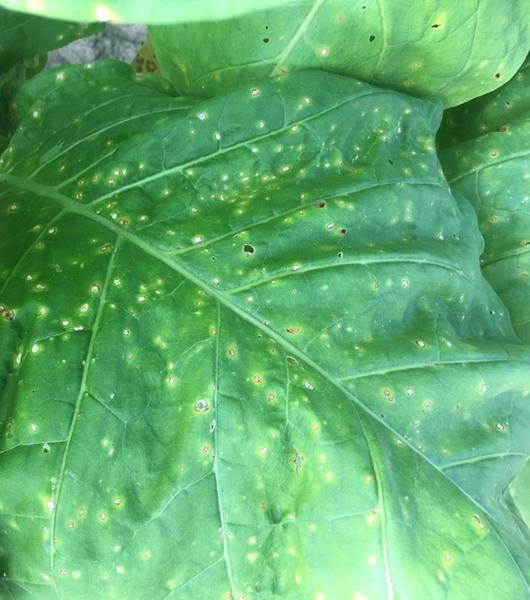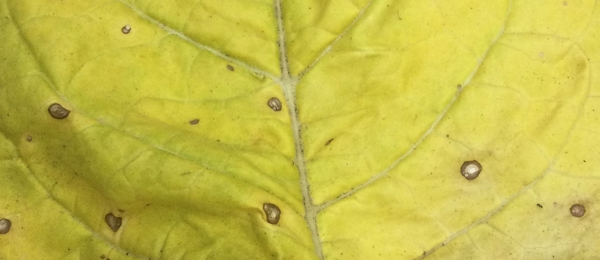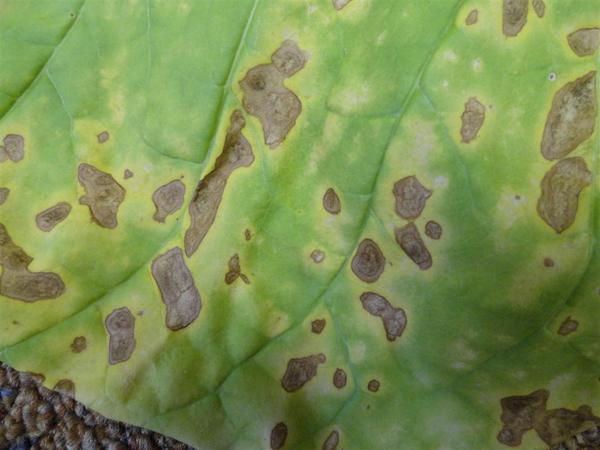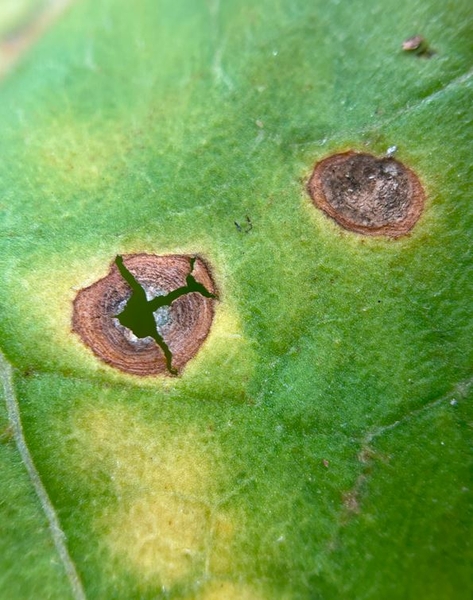Introduction
Frogeye leaf spot disease on flue-cured tobacco is caused by the fungal pathogen, Cercospora nicotianae, first reported in North Carolina, US by Ellis and Everhart (1893). Frogeye can affect tobacco at all stages of growth and after harvest, but occurs most frequently on mature tobacco. While frogeye leaf spot can affect younger, green tissue, the disease is often limited to the lower, more mature leaves of the plant (Lucas 1975). Infections are not often severe enough to impact yield, but, under conducive environmental conditions, can cause severe damage to leaves (Shew and Lucas 1991).
Pathogen
Frogeye leaf spot is caused by the anamorphic, ascomycete fungus, Cercospora nicotianae (Lucas 1975), which has no known sexual phase (Sivanesan 1984). The fungus is economically important in tobacco, but has a broad host range, including Glycine max (soybean), Daturia stramonium (jimsonweed), Nicandra physalodes (apple of Peru), Pysalis angulata (cutleaf groundcherry), Solanum lycopersicum (tomato), Solanum melongena (eggplant / aubergine), Solanum nigrum (black nightshade), and several more weeds (https://www.mycoportal.org/portal/collections/index.php).
Symptoms and Signs
Frog eye lesions begin as small (<1-1mm), round to ovoid (Figure 1), sunken white/tan spots (Figure 2). As the lesions grow up to 15 mm, they generally have a reddish-to-dark brown margin with tan-to-gray centers. On green leaves, a yellow halo can be seen extending out from the dark margin. A black area can be seen in the center of older lesions, as the dark colored fruiting bodies (pseudostromata) are produced (Mulder and Holliday, 1974). Conidiophores and conidia emerge from these stroma, and under magnification appear as long, thin, and hair-like with a gradual, uniform curve along its length (Mulder and Holliday, 1974).
Diseases with Similar Symptoms
Brown spot (Alternaria spp., Figure 3).
This disease produces dark brown lesions that become irregular shaped as they coalesce to large lesions. Lesions begin as small yellow spots that may be confused with early frogeye leaf spot lesions.
Target spot (Rhizoctonia solani, Figure 4).
This disease produces brown lesions, and commonly concentric rings of growth within the brown lesions can be observed. Because lesions begin as small, yellow spots, it may also be confused with early infections caused by frogeye leaf spot.
Disease Cycle
The polycyclic fungus overwinters as pseudostromata in infected debris from previous crops or alternate hosts or may be introduced to a field through infected seedlings (Tan et al. 2023). Wet weather, irrigation, and temperatures around 27°C (80.6°F) will trigger the overwintering structures to become active and produce conidia (Roy and Dam, 2015). Conidia are dispersed by water and air to reach their new host. Spores will then germinate and hyphae will penetrate the tissue of the leaf. As a hemibiotrophic pathogen, the fungus starts infection as symptomless, biotrophic growth for the first few days and later switches to a necrotrophic phase, which triggers the death of host cells (Daub et al. 2013). As hyphae spread, the leaf tissue dies, forming a necrotic lesion. New fruiting bodies (pseudostromata and conidiophores) are formed within the leaf lesion on both sides of the leaf (Zhao et al., 2020). Conidiophores and conidia are released from the fruiting bodies to continue spreading and reproducing, as long as conditions are conducive for disease (Housni, et al. 2023).
Disease Management
There are no resistant varieties or effective chemical controls for frogeye leafspot. Azoxystrobin is registered for use on tobacco in the USA for suppression of frogeye leaf spot (https://www.cdms.net/Label-Database) ; however, azoxystrobin resistance in C. nicotianae populations has been detected in the USA and South American countries, confirmed through the identification of F129L and G143A mutations in the Cytochrome b gene of the species (Ernst and Theissen 2020). Cultural practices are most important for limiting damages by C. nicotianae.
Exclusion and Sanitation.
While frogeye leaf spot is not currently common in greenhouses, infected transplants may spread disease into a previously unaffected field. Avoid transplanting new plants near more mature plants that can harbor and spread the disease.
The pathogen can be moved in infested soil via equipment, vehicles, tools, or shoes that have entered the field. Equipment from fields with frogeye leaf spot should be sanitized before moving to unaffected fields. Workers should also sanitize shoes after working in infected fields. Working in fields with known histories of frogeye leaf spot last will reduce time and effort needed for sanitation of equipment.
Field sanitation is an important step in managing this disease and reducing its spread. Control weeds, as they may act as alternate hosts. Destroying stalks and roots quickly after harvest will help reduce inoculum. Contaminated irrigation or runoff water may also aid in its movement within a field or from one field to another. Improving drainage in areas where water pools can reduce the environmental suitability of the soil.
Crop Rotation.
Crop rotation with non-hosts (not soybean, tomato, eggplant, and other solanaceous crops) can be used in rotation to help reduce inoculum in the soil. Longer rotations will reduce inoculum more than shorter rotations.
Plant Health.
Adequate nutrition (not deficient nor excessive) for encouraging vigorous growth of leaves and limiting excess growth may reduce the impact of frogeye leaf spot. Additionally, proper plant spacing and sucker control will limit humidity in plant canopies, reducing frogeye leaf spot incidence.
Useful Resources
- The Tobacco Disease Information page developed by Dave Shew has more information about target spot of tobacco.
- The NC State University Plant Disease and Insect Clinic provides diagnostic and control recommendations.
- The NCSU Extension Plant Pathology portal provides information on crop disease management.
- The North Carolina Agricultural Chemicals Manual provides pesticide information for common diseases of North Carolina crops. Recommendations do not replace those described on the pesticide label; the label must be followed.
- Your N.C. Cooperative Extension agent
Publication date: Jan. 6, 2020
Reviewed/Revised: Oct. 21, 2024
N.C. Cooperative Extension prohibits discrimination and harassment regardless of age, color, disability, family and marital status, gender identity, national origin, political beliefs, race, religion, sex (including pregnancy), sexual orientation and veteran status.
NC Cooperative Extension prohíbe la discriminación por raza, color, nacionalidad, edad, sexo (incluyendo el embarazo), discapacidad, religión, orientación sexual, identidad de género, información genética, afiliación política, y estatus de veteran.
The use of brand names in this publication does not imply endorsement by NC State University or N.C. A&T State University of the products or services named nor discrimination against similar products or services not mentioned.
Recommendations for the use of agricultural chemicals are included in this publication as a convenience to the reader. The use of brand names and any mention or listing of commercial products or services in this publication does not imply endorsement by NC State University or N.C. A&T State University nor discrimination against similar products or services not mentioned. Individuals who use agricultural chemicals are responsible for ensuring that the intended use complies with current regulations and conforms to the product label. Be sure to obtain current information about usage regulations and examine a current product label before applying any chemical. For assistance, contact your local N.C. Cooperative Extension county center.
N.C. Cooperative Extension prohibits discrimination and harassment regardless of age, color, disability, family and marital status, gender identity, national origin, political beliefs, race, religion, sex (including pregnancy), sexual orientation and veteran status.




